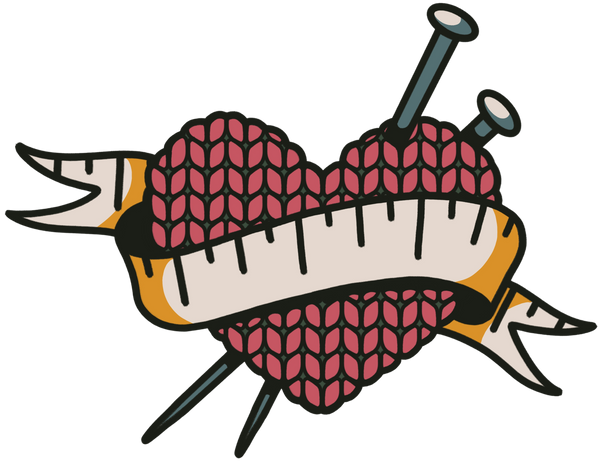
Fit Issues - Back Armhole Depth
It’s Jen here today, and I have been BURSTING to talk about my Kanno's Resistance.
I had to keep this tee a secret from everyone when I was working on it, because I wanted to surprise Elizabeth when she came up to the photoshoot. That meant no talking about mods while I was working on it, and that just about did me in. So we're doing it now!
I'm sharing this with you today because Kanno is now available, but I'm hoping that this post will be one you learn a lot from and can take with you to work on other projects.

"Design to knit" vs. "design to fit"
We talk frequently about the balance between “designing to knit” vs. “designing to fit.” On one end of the spectrum, we might have a basic drop shoulder design that’s a series of rectangles. Easy to knit, but maybe it’s going to require a lot of work to get it to look the way you imagine it on your body.
On the other end, we have garments that are incredibly tailored-looking, built to respond to every curve on the body. They’ll look amazing, but take a lot more focus while you’re knitting. Plus, if you don’t match all those curves exactly, you’ll have to unpack some of those details and repack them in a way that meets your personal needs.
I personally prefer to knit projects that lean heavily towards designed to fit, and that’s also what we try to do with One Wild patterns. That means that most of my modifications go towards making the fit bespoke, rather than re-writing the bones of the pattern.
I had to have a Kanno of my own
This winter, I fell in love with Bess’s upcoming design Kanno, and wanted one of my own. It’s a special yarn, and it was a special treat to buy it for myself so I knew I’d want to make sure the fit was perfect for me. When I knit a sample that will be in a pattern, I can't really make customized modifications: I need to show you what the sweater will look like if you follow my instructions.
For Kanno, I knew I wanted to make some aesthetic adjustments so it would shine in my wardrobe, but I was also looking forward to playing with some of the mods I'm constantly recommending!
Note, all of these modifications were planned out entirely before I cast on. Mods frequently impact each other, so it's important to have all of the changes mapped out before knitting them up and running into an issue.

Modifications that change the style/design of a pattern
Before planning my fit changes, there were two silhouette changes I needed to plan: I wanted my Kanno to be much shorter, and I wanted the front neck just a little bit deeper.
To make the garment shorter, I figured out how many rows I wanted between the underarm and the hem. Because Kanno has decreases for gentle hip shaping, I redistributed those rows to be evenly spaced in the new length.
To lower the front neck, I figured out how much deeper I wanted it to be and converted the difference to rows. I then started the neckline shaping that many rows earlier.
Since I needed to work short rows to shape the shoulders at the same time as shaping the neck, I made a quick progress chart that showed each row in the top of the front, and mapped the shoulder shaping and the neck shaping so I would know what to do on each row.

Visually, you can see my design mods - the garment is shorter and has shorter sleeves.
Making fit modifications
Once I had my style changes locked down, I needed to plan out my fit modifications.
When fitting, we always plan top down. That means making any adjustments to the neck, then the yoke, then the sleeves and body.
Our backs are not the same as our fronts
Generally speaking, our back armhole is a little deeper than our front armhole. We don’t typically address this in knitting patterns - we typically see garments that are the same from the underarms up in the front and back.
Tip: If you’ve seen our guidance on measuring your upper chest, you know that the tape measure comes up at an angle under the arms. That’s because the back underarm is lower than the front underarm!
I lengthened the back yoke
It’s not usually a big deal that we don’t address this, but adding just a few rows to the back of your yoke can help get a better fit (and if your upper back is at all rounded, can also help prevent you from being choked by your sweater).
I decided to add 4 rows to the back of my Kanno - which meant I’d need to pick up two extra stitches in the back of the sleeve and decrease them out in the lower cap shaping to arrive at the same bicep circumference.

I made the back shoulders wider
I also wanted to add just a few stitches to the back width of my sweater - most of us are just a smidge wider in the back than the front, and adding a quarter inch to the back of each side is a way to improve the fit. I decided to omit a few of the armhole shaping decreases in the back. The front and back shoulders get seamed together, so to keep the back shoulders the same width I knew I’d need to bind off a few extra stitches in the neck.
I lowered the bust dart
Finally, I have a lower bust apex than the fit model for my size. I knew I wanted to lower the bust dart by about 1.3 inches.
Total portfolio of changes
So what did I do to make this sweater my own and make it fit better?
- Removed 5” of length between the hem and the underarm, and shortened the sleeves
- Lowered the front neck by 1”
- Lowered the bust dart by 1.35”
- Lengthened the back yoke by .5”
- Widened the back neck and shoulders by .5”
- I also worked a 1x1 rib for the neckline and sleeves, but this is mostly because I got distracted and that’s how it ended up happening. Don’t judge me!
Make YOUR projects your own
I’d love to encourage you to play around with some of the numbers in YOUR patterns. If your sweaters slide back on your shoulders, or your necks rise up in the front and choke you even though they have shaping? Add some length to the back. If your bust darts are too high or too low, you can move them by working more or fewer rows. Even small changes can make a big impact, and we hope you'll use this set of examples as a way to get going on your own perfectly fitted sweater!
